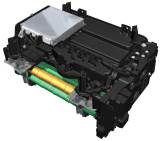
A SURGE OF FUNDING FOR BATTERY TECHNOLOGY
The Car Care Council |
 |
By Brandon Boyd,
Contributing Editor
 |
With $2 billion of the stimulus package earmarked for battery technology green cars are receiving the jolt they need. |
One of the biggest hurdles for battery powered hybrids and plug-in electric cars is their price tag. Buying that green car means shelling out plenty of green from your own pocket despite the narrow profit margin for the automakers. So, does Washington have the answer to make battery powered cars a cost effective, efficient, in-the-showroom option?
To answer that, let’s follow the money. The president’s stimulus package, now being called the American Recovery and Reinvestment Act, was signed into law on Feb. 17, 2009. From the $789 billion act, $16.8 billion was appropriated for the Department of Energy to distribute. A $2 billion piece of this cash filled pie was to be administered by the DOE in the form of grants for advanced battery technology. The funds were to be handed out by the DOE through its vehicle technologies program which touts the goal of developing more energy efficient and environmentally friendly autos.
The day after the act was signed into law, an employee from the DOE remarked, “there is no official timetable but my understanding is that the White House wants to disburse these funds A.S.A.P.”
The Energy Department was quick to respond to direction from the White House. Two days after the act was signed, a press release was issued by Energy Secretary Steven Chu setting a rough timetable and outlining the quick disbursement of funds. In the release, Secretary Chu set forth a plan to issue new loan guarantees under the recovery act by early summer and to disburse 70 percent of the investment from the act by the end of 2010. That’s a lot of cash in a short period of time.
This quick disbursement was good news for CEO Edward Williams of Firefly Energy, a manufacturer of advanced lead acid batteries – think of your regular car battery on steroids.
Williams is pursuing DOE funding for engineering and building a manufacturing plant for the company’s next generation 3D-squared microcell foam battery technology. Confusing? Here is something more concrete: Once the 3D-squared plant is built the company’s goal is to supply up to 100,000 vehicles per year with advanced batteries. To put this number into perspective, Toyota sold approximately 160,000 Prius hybrid vehicles in 2008.
Let’s examine another player in the automotive battery market: A123 Systems. With strong ties to Chrysler and General Motors, A123 had a loan application waiting for approval from the DOE totaling $1.84 billion to build U.S. based lithium-ion battery manufacturing facilities. The goal of A123 Systems is to provide battery systems for five million hybrid vehicles or 500,000 plug-in electric vehicles by 2013 when the plants are at full production according to a recent press release. The first battery plant was slated to be built in southeast Michigan, no doubt a fitting location for the green revolution.
A123 Systems, a developer and manufacturer of advanced Nanophosphate™ lithium ion batteries and systems, announced on September 23, 2010 the grand opening of the largest lithium ion automotive battery production facility in North America, based on available data. The new plant in Livonia, Mich. planned to expand A123's manufacturing capabilities by up to 600MW hours per year when fully operational contributing to the company's plan to expand global final cell assembly capacity to more than 760MW hours annually by the end of 2011.
The opening of the Livonia factory comes just over one year after A123 was awarded a $249 million grant from the U.S. Department of Energy (DOE) as part of the American Recovery and Reinvestment Act to help the company execute its strategy to ramp up U.S. manufacturing capabilities to meet increasing, market driven demand for its innovative technologies.
What are the hurdles for vehicle based batteries? Lithium-ion cells, like the ones planned for the Chevy Volt, are popular because of their energy density. They store a lot of energy for their weight compared to other types of batteries, but are expensive to manufacture. Some of the main elements used in these batteries are lithium, manganese and cobalt which are very expensive to dig up from terra firma. As demand for these elements increases so do the prices. Battery companies are adjusting to these challenges by experimenting with various materials to make these batteries cheaper and more efficient.
Tesla Motors found a way to squeeze out an average 220 miles per charge of its 2009 Roadster using lithium-ion cells. It also came with staggering acceleration times and a $100,000 price tag that is out of reach for most of us. The high tech batteries are at the bleeding edge level at this point. Perhaps, a little more time and money can bring them into a leading edge reality.
This reality comes closer to home with the new administration’s support for battery technology through this influx of funding. The battery manufacturers have been poised for a rapid expansion in manufacturing as these government funds became available. This should translate into cheaper, more advanced batteries for hybrid and plug-in electric vehicles bringing that price tag down to a more manageable level for the average car buyer.
With $2 billion of the stimulus package slated for battery technology, green cars are receiving the jolt they need. Consumers are more than willing to switch to a cleaner, effective, electron juiced car but not if it means giving up the luxury, convenience and performance of current petroleum based autos.
When the Chevy Volt can blow the doors off a Mustang GT and keep the wheels spinning for 500 miles per charge consumers will fall in love. Ditching the spaceship bubble look couldn’t hurt either.